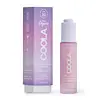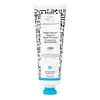What's inside
What's inside
 Key Ingredients
Key Ingredients

 Benefits
Benefits

 Concerns
Concerns

 Ingredients Side-by-side
Ingredients Side-by-side

Hyaluronic Acid
HumectantNelumbo Nucifera Flower Extract
Skin ConditioningButyl Methoxydibenzoylmethane 2%
UV AbsorberHomosalate 10%
Skin ConditioningEthylhexyl Salicylate 5%
UV AbsorberOctocrylene 6%
UV AbsorberAloe Barbadensis Leaf Extract
EmollientAnthemis Nobilis Flower Oil
MaskingButylene Glycol
HumectantButyloctyl Salicylate
Skin ConditioningCalcium Gluconate
HumectantCaprylic/Capric Triglyceride
MaskingCarthamus Tinctorius Seed Oil
MaskingCitrus Aurantium Amara Flower Extract
RefreshingCitrus Aurantium Amara Leaf/Twig Extract
Skin ConditioningDicaprylyl Carbonate
EmollientGlycerin
HumectantGlyceryl Stearate Se
EmulsifyingJasminum Sambac Leaf Cell Extract
MaskingNylon-12
Olea Europaea Fruit Oil
MaskingPlankton Extract
Skin ConditioningPropanediol
SolventSchinus Molle Extract
Skin ProtectingSimmondsia Chinensis Seed Oil
EmollientSodium Benzoate
MaskingSodium Hyaluronate
HumectantSodium Stearoyl Glutamate
CleansingTheobroma Cacao Seed Extract
AntioxidantTocopheryl Acetate
AntioxidantWater
Skin ConditioningXanthan Gum
EmulsifyingHyaluronic Acid, Nelumbo Nucifera Flower Extract, Butyl Methoxydibenzoylmethane 2%, Homosalate 10%, Ethylhexyl Salicylate 5%, Octocrylene 6%, Aloe Barbadensis Leaf Extract, Anthemis Nobilis Flower Oil, Butylene Glycol, Butyloctyl Salicylate, Calcium Gluconate, Caprylic/Capric Triglyceride, Carthamus Tinctorius Seed Oil, Citrus Aurantium Amara Flower Extract, Citrus Aurantium Amara Leaf/Twig Extract, Dicaprylyl Carbonate, Glycerin, Glyceryl Stearate Se, Jasminum Sambac Leaf Cell Extract, Nylon-12, Olea Europaea Fruit Oil, Plankton Extract, Propanediol, Schinus Molle Extract, Simmondsia Chinensis Seed Oil, Sodium Benzoate, Sodium Hyaluronate, Sodium Stearoyl Glutamate, Theobroma Cacao Seed Extract, Tocopheryl Acetate, Water, Xanthan Gum
Zinc Oxide 20%
Cosmetic ColorantWater
Skin ConditioningCaprylic/Capric Triglyceride
MaskingDicaprylyl Carbonate
EmollientPentylene Glycol
Skin ConditioningGlycerin
HumectantSteareth-2
EmulsifyingPropanediol
SolventSteareth-21
CleansingPolyhydroxystearic Acid
EmulsifyingCetearyl Alcohol
EmollientSilica
AbrasiveSclerocarya Birrea Seed Oil
HumectantAloe Barbadensis Leaf Extract
EmollientChondrus Crispus Extract
Skin ConditioningHaematococcus Pluvialis Extract
AntioxidantHelianthus Annuus Sprout Extract
Skin ConditioningVitis Vinifera Juice Extract
AntioxidantHelianthus Annuus Seed Oil
EmollientSimmondsia Chinensis Seed Oil
EmollientRaspberry Seed Oil/Tocopheryl Succinate Aminopropanediol Esters
Skin ConditioningHydrolyzed Wheat Protein
Skin ConditioningTocopheryl Acetate
AntioxidantTocopherol
AntioxidantSea Water
HumectantAcetyl Glucosamine
Skin ConditioningCetearyl Glucoside
EmulsifyingSodium Stearoyl Glutamate
CleansingTetrahexyldecyl Ascorbate
AntioxidantGlycine
BufferingSucrose
HumectantLecithin
EmollientTriethoxycaprylylsilane
Xanthan Gum
EmulsifyingTrisodium Ethylenediamine Disuccinate
Caprylhydroxamic Acid
Caprylyl Glycol
EmollientPhenoxyethanol
PreservativeChlorphenesin
AntimicrobialSodium Dehydroacetate
PreservativeCI 77491
Cosmetic ColorantZinc Oxide 20%, Water, Caprylic/Capric Triglyceride, Dicaprylyl Carbonate, Pentylene Glycol, Glycerin, Steareth-2, Propanediol, Steareth-21, Polyhydroxystearic Acid, Cetearyl Alcohol, Silica, Sclerocarya Birrea Seed Oil, Aloe Barbadensis Leaf Extract, Chondrus Crispus Extract, Haematococcus Pluvialis Extract, Helianthus Annuus Sprout Extract, Vitis Vinifera Juice Extract, Helianthus Annuus Seed Oil, Simmondsia Chinensis Seed Oil, Raspberry Seed Oil/Tocopheryl Succinate Aminopropanediol Esters, Hydrolyzed Wheat Protein, Tocopheryl Acetate, Tocopherol, Sea Water, Acetyl Glucosamine, Cetearyl Glucoside, Sodium Stearoyl Glutamate, Tetrahexyldecyl Ascorbate, Glycine, Sucrose, Lecithin, Triethoxycaprylylsilane, Xanthan Gum, Trisodium Ethylenediamine Disuccinate, Caprylhydroxamic Acid, Caprylyl Glycol, Phenoxyethanol, Chlorphenesin, Sodium Dehydroacetate, CI 77491
 Reviews
Reviews

Ingredients Explained
These ingredients are found in both products.
Ingredients higher up in an ingredient list are typically present in a larger amount.
Aloe Barbadensis Leaf Extract is an extract of the leaves of the aloe, Aloe barbadensis, Liliaceae.
Aloe is one of the most well-known natural soothing ingredients, and for good reason. It’s full of water and has a cooling, calming effect on the skin, especially when it’s sunburned, itchy, or irritated. Aloe also helps your skin stay hydrated and smooth by mimicking what healthy skin naturally produces. On top of that, it contains vitamins and nutrients that support skin recovery.
It doesn’t protect you from the sun, but it can help your skin bounce back after too much time in it.
Let’s get into the details:
Aloe contains antioxidant Vitamins A, C, and E, which help fight off free radicals (unstable molecules from things like pollution that can damage your skin).
It’s also rich in polysaccharides, which are natural sugars that help hydrate the skin by acting like the skin’s own moisturizing agents. These, along with other sugars like monosaccharides, help form a protective barrier that locks in moisture.
Aloe works as both a humectant and an emollient. That means it draws water into the skin (humectant) and helps trap it there (emollient), making it an effective natural moisturizer.
You’ll also find a mix of other skin-supporting ingredients in aloe, including folic acid, choline, calcium, amino acids, fatty acids, and even Vitamin B12.
Out of the 420+ species of aloe, Aloe barbadensis is the most widely used in skincare products thanks to its gentle yet effective properties.
There are over 420 species of aloe but Aloe Barbadensis is the most commonly used for topical products.
Learn more about Aloe Barbadensis Leaf ExtractThis ingredient is an emollient, solvent, and texture enhancer. It is considered a skin-softener by helping the skin prevent moisture loss.
It helps thicken a product's formula and makes it easier to spread by dissolving clumping compounds.
Caprylic Triglyceride is made by combining glycerin with coconut oil, forming a clear liquid.
While there is an assumption Caprylic Triglyceride can clog pores due to it being derived from coconut oil, there is no research supporting this.
Learn more about Caprylic/Capric TriglycerideDicaprylyl Carbonate comes from carbonic acid and caprylyl alcohol, a fatty alcohol. It is an emollient and gives skin a velvet feel. The sources of Dicaprylyl Carbonate may be synthetic or from animals.
As an emollient, Dicaprylyl Carbonate creates a film on the skin. This film traps moisture in, keeping your skin soft and hydrated.
Glycerin is already naturally found in your skin. It helps moisturize and protect your skin.
A study from 2016 found glycerin to be more effective as a humectant than AHAs and hyaluronic acid.
As a humectant, it helps the skin stay hydrated by pulling moisture to your skin. The low molecular weight of glycerin allows it to pull moisture into the deeper layers of your skin.
Hydrated skin improves your skin barrier; Your skin barrier helps protect against irritants and bacteria.
Glycerin has also been found to have antimicrobial and antiviral properties. Due to these properties, glycerin is often used in wound and burn treatments.
In cosmetics, glycerin is usually derived from plants such as soybean or palm. However, it can also be sourced from animals, such as tallow or animal fat.
This ingredient is organic, colorless, odorless, and non-toxic.
Glycerin is the name for this ingredient in American English. British English uses Glycerol/Glycerine.
Learn more about GlycerinPropanediol is an all-star ingredient. It softens, hydrates, and smooths the skin.
It’s often used to:
Propanediol is not likely to cause sensitivity and considered safe to use. It is derived from corn or petroleum with a clear color and no scent.
Learn more about PropanediolThis oil comes from the seeds of the desert shrub called Jojoba. It is more commonly known as jojoba oil, a non-comedogenic oil.
Jojoba oil does not contain fragrance and has many fatty-acids, making it a great soothing ingredient.
It also contains Vitamin E, a great moisturizing ingredient. Vitamin E is also an antioxidant and protects your skin against oxidative damage.
This ingredient humectant properties, meaning it helps draw moisture from the air. This helps keep your skin hydrated.
While jojoba has antibacterial properties, it is only able to kill some strains of bacteria.
Studies also show it helps in wound healing. In fact, Indigenous cultures have used jojoba as a moisturizer and to help treat burns for centuries.
Fun fact: Jojoba oil similar to natural human skin sebum, so it has a great effect on dry skin. It is also promising with helping to regulate sebum production.
Due to its fatty acid content, Jojoba oil may not be fungal acne safe. We recommend speaking with a professional if you have any concerns.
Learn more about Simmondsia Chinensis Seed OilSodium Stearoyl Glutamate is an emulsifier and helps condition the skin. It is amino acid-based.
In higher amounts, it may act as a cleansing agent.
Tocopheryl Acetate is AKA Vitamin E. It is an antioxidant and protects your skin from free radicals. Free radicals damage the skin by breaking down collagen.
One study found using Tocopheryl Acetate with Vitamin C decreased the number of sunburned cells.
Tocopheryl Acetate is commonly found in both skincare and dietary supplements.
Learn more about Tocopheryl AcetateWater. It's the most common cosmetic ingredient of all. You'll usually see it at the top of ingredient lists, meaning that it makes up the largest part of the product.
So why is it so popular? Water most often acts as a solvent - this means that it helps dissolve other ingredients into the formulation.
You'll also recognize water as that liquid we all need to stay alive. If you see this, drink a glass of water. Stay hydrated!
Learn more about WaterXanthan gum is used as a stabilizer and thickener within cosmetic products. It helps give products a sticky, thick feeling - preventing them from being too runny.
On the technical side of things, xanthan gum is a polysaccharide - a combination consisting of multiple sugar molecules bonded together.
Xanthan gum is a pretty common and great ingredient. It is a natural, non-toxic, non-irritating ingredient that is also commonly used in food products.
Learn more about Xanthan Gum